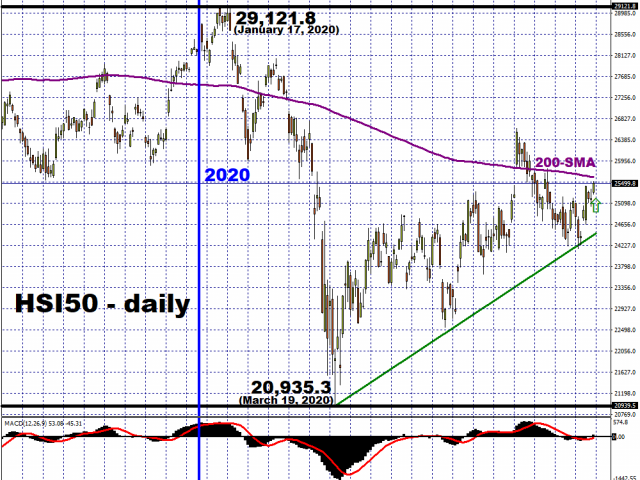The Hang Seng index is gaining over one percent at the start of the trading week, following last Friday’s announcement of the index’s new lineup effective September 7.

Alibaba Group Holding, Xiaomi Corp., and Wuxi Biologics Cayman Inc. will be taking the place of Sino Land Co., Want Want China Holdings, and China Shenhua Energy Co. on the list of 50 companies included in the city’s benchmark index. Surprisingly, Meituan Dianping didn’t make the cut this time around.
Since it was first published on July 31, 1964 with a base of 100 points, the Hang Seng index climbed to a record closing price of 33,154.12 on January 26, 2018. However, since that all-time peak, it has declined by 24 percent until last week’s close on August 14. Still, the uptrend over the past 50 years remains intact.
Looking ahead to September 7, 2020, the changes to the its list of 50 constituents could shift about US$30 billion worth of pension funds and ETFs that are linked to the index. The inclusion of these tech behemoths such as Alibaba and Xiaomi will also reduce the index’s reliance on financial stocks.
However, Alibaba will only account for a maximum of five percent of the index, which is the maximum allowed for secondary listings under the rules by Hang Seng Indexes. Recall that Alibaba’s shares listed in Hong Kong in November last year, some five years after it went public on the New York Stock Exchange. The lower weightage comes despite Alibaba’s market cap of HKD 5.3 trillion (US$ 680 billion) in Hong Kong being larger than Tencent’s HKD 4.85 trillion (US$ 630 billion) market value, as of August 14, 2020. Yet, Tencent accounts for some 11.2 percent of the index, AIA Group has a 10.5 percent weighting, with HSBC’s 8.5 percent weight rounding up the top three biggest members of the benchmark index. Still, market observers expect Alibaba’s weightage to gradually be increased.
With this change in three weeks, perhaps it could be the catalyst for the index to break out its multi-year slump and keep it above its 200-day simple moving average (SMA). After all, the HSI50 has clearly lagged its regional peers, despite gaining some 20 percent since its March 19 trough which was its lowest level since 2016. For comparison, the MSCI Asia Pacific index and Alibaba’s stocks in Hong Kong both climbed 40 percent respectively since March 19.
The addition of Alibaba and Xiaomi could help the HSI50 reflect the outperformance of tech stocks amid the pandemic. After all, the tech sector has been the driving force behind the S&P 500 nearing its record-high of late, despite the economic woes wrought upon by the pandemic.
MyFxtops 邁投 (www.myfxtops.com) -Reliable Forex Copy Trade community, follow the master for free to trade!
Disclaimer: This article is reproduced from the Internet. If there is any infringement, please contact us to delete it immediately. In addition: This article only represents the personal opinion of the author and has nothing to do with Mato Finance The originality and the text and content stated in this article have not been confirmed by this site. The authenticity, completeness and timeliness of this article and all or part of the content and text are not guaranteed or promised. Please refer to it for reference only Verify the content yourself.
Copyright belongs to the author.
For commercial reprints, please contact the author for authorization. For non-commercial reprints, please indicate the source.

 MyFxTops邁投財經
MyFxTops邁投財經
